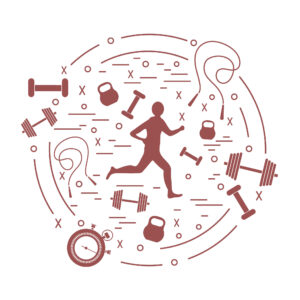Despite its widespread benefits, engagement in physical activities or exercise remains scarce, primarily reported a result of a ‘lack of time’. How can personal trainers make the best use of their client’s time while still enabling notable performance results? Variations of Interval Training, such as Reduced-Exertion High-Intensity Interval Training or REHIIT, can be both an appropriate and beneficial course of action for training senior clients.
Time-efficient and power-generating results may be enabled by Interval Training in multiple protocols, including:
- SIT (Sprint Interval Training)
- HILIT (High-Intensity, Low-Impact Training)
- HIIT (High-Intensity Interval Training) with multiple protocols:
- Micro-HIIT and
- REHIIT (also known as REHIT) – (Reduced-Exertion High-Intensity Interval Training).
- Swedish “speed play” sessions, which are usually associated with running, called FARTLEKs, as these two older runners are enjoying below.
As safety and injury-prevention are paramount concerns, it is good to reinforce the conditionality of the AARP’s Silver Sneaker advice for any HIIT protocol;
“After you’ve built a solid foundation of strength, flexibility, and core stability, then you can start to incorporate HIIT into your workouts…older adults who are interested in HIIT should strongly consider working with a personal trainer.”
Whichever time saving and life-extending interval training variant or hybrid method you choose for an older client (aged 60 or higher); basic cardiovascular, strength, stretching, and stability factors should be key elements for your exercise programming and execution stages.
Incorporating REHIIT
Fallacies or misleading attributes of high-intensity interval training abound as relevant reminders/caveats for your intent, purpose, older client readiness, and safe performance goals. When training older clients who are ready and able, traditional HIIT protocols can be modified with a little savvy and planning.
You might use the classic FITT model to program safe interval training for older clients with four programming criteria:
- Frequency
- Interval
- Time
- Type (Specificity) – which is based on a client’s estimated “fitness or gym age”, a Medical Doctor’s assessment, and your own functional assessment.
Compare and contrast subjective FITT criteria for HIIT protocols for younger, more fit clients with older/beginner fitness clients [Table 1]:
Table 1. Comparison of HIIT Readiness by Criterion
A. Client is a current, powerful Athlete or well-trained exerciser seeking to improve performance:
Exercise Programming Criterion Detail
- Frequency One to 2 dedicated HIIT sessions weekly (of 5-6 total weekly workouts)
- Interval Peak at ~90% to 95% of Maximum Heart Rate in several “up-tempo” segments
- Time Complete several hours before bedtime to prevent sleep disruptions. Have at least one recovery day before another “up-tempo” session.
- Type (Specificity) Resistance, Stamina, or a Combination programmed for the client’s overall health benefits.
B. Client is new to HIIT or has an existing clinical condition (while medically cleared to exercise):
Exercise Programming Criterion Detail
- Frequency One REHIIT session weekly (of a client’s 3-5 total weekly workouts)
- Interval Client safely peaks at ~80% of Maximum Heart Rate in the few “up-tempo” segments
- Time Complete several hours before bedtime to better chances for restful sleep habit
- Type (Specificity) Focus on stamina boosts for the client’s specific Cardio-Respiratory Fitness (CRF) as a baseline.
Credit: NFPT
NOTE: A CPT’s knowledge is critical to adapt and tailor a regimen for each older client when she or he is training for vital Cardio-Respiratory Fitness(CRF) gains and demonstrations of generated power.
When reviewing the tables above, you will see in Section B clients incorporate less Frequency and relatively lower Intensity efforts than clients in Section A. Whether a client repeats the same exercise in her or his intervals, or shifts among multiple exercises, the cardiovascular and cardiorespiratory benefits are similar.
More specific regimens to benefit major muscle groups may be tuned as the CPT deems appropriate for an individual older client.
Benefits of REHIIT
Attributes of effective interval training [IT] for almost any client are:
- Boosted heart rate
- Lower blood pressure (post-recovery)
- Complex exercise execution
- Improved heart rate recovery
- Very high aerobic and possible anaerobic energy taps.
- More efficiency and potential time savings over longer, lower-intensity sessions.
Thus, when done properly and safely, older [medically cleared] clients can leverage tailored interval training sessions to benefit from:
√ Metabolizing fat as a stored energy source (boosting duration and caliber of EPOC or afterburn)
√ The relatively short timeframe of a workout (compared to long, steady-state efforts)
√ Improved C-V pumping capacity, known as “Cardio-Respiratory Fitness” or CRF
√ Improved Lipoprotein levels (raise HDL, lower LDL)
√ Enhance insulin sensitivity and limit Metabolic Syndrome (MetS) factors – at least for non-adult diabetic (T2D) clients
√ Lower Systolic Blood pressure readings.
REHIIT Research and Planning
As a Medicare-aged Master Fitness Trainer, I underscore the importance of phasing for any kind of IT. As a client’s fitness is a journey that spans many weeks and months, it is far better to embark slowly than to jump right in.
When an older client has been medically cleared for challenging “up-tempo” heart rate and whole-body exercise, REHIIT can serve as a prudent progressive step toward other challenging “I T” variants or protocols as listed above.
As the NIA and NIH document, even REHIIT efforts can surpass steady-state moderate-intensity exercise for longevity and fitness rewards! In one study, the reduced exertion regimen was two 20-second sprints in an otherwise 30-minute steady-state session on an instrumented exercise bicycle.
Recall that a TABATA protocol has eight (8) sprint intervals of 20 seconds with only 10-second rest segments.
“The main finding [of this initial study] … is that 8 weeks of REHIIT was safe and elicited more potent, time-efficient improvements in CRF and cardiometabolic health when compared to traditional mild intensity cardio training.”
More studies are needed to (potentially) lock-in public health recommendations for our general population.
Older clients, who can adapt to higher heart rate and complex exercise “sprints”, should gain longevity and health benefits which are superior to mild steady-state activities they would solely do.
British researchers also noted in a credible pilot study that “REHIT is superior to a five-fold larger volume of moderate-intensity walking in improving aerobic fitness.”
Thus, a relatively short “mild” training sessions with a few 20-second “up-tempo” intervals of higher heart rate activity can be five times more time-efficient and effective than mild/low intensity, steady-state activity.
A third credible, albeit small, study involved adult patients with Cystic Fibrosis (CF). This study also programmed a few “sprints” or “bumps” of 20 seconds interspersed with milder activity in stamina workouts. This pilot suggests that older patients with medical conditions like CF or Type 2 Diabetes may be able to achieve CRF gains.
Summary
This evaluation and selective endorsement of Reduced Exertion Interval Training for older clients that aligns with FITT principles because:
- REHIIT can be a time-saver and be safe fun for some older clients (who are cleared medically and have validated their good bases for strength, flexibility, and stability)
- Even a few up-tempo or sprint intervals between low/moderate heart rate activity segments promote CRF benefits for older clients after ~8 to 10 weeks of tailored REHIT programming.
- Recovery considerations for your older clients suggest these IT workouts should be limited to no more than 2 times per week.
- Depending on an older client’s psyche and desire for variation, REHIT can be used for stamina, resistance training, or mixed/hybrid sessions.
- As with any stressing activity, the trainer and older client must be safety-tuned to warning signs before, during, and after a client’s interval workout. This is critical if your cleared patient has a certain medical or physical condition such as Type 2 Diabetes or Metabolic Syndrome.





